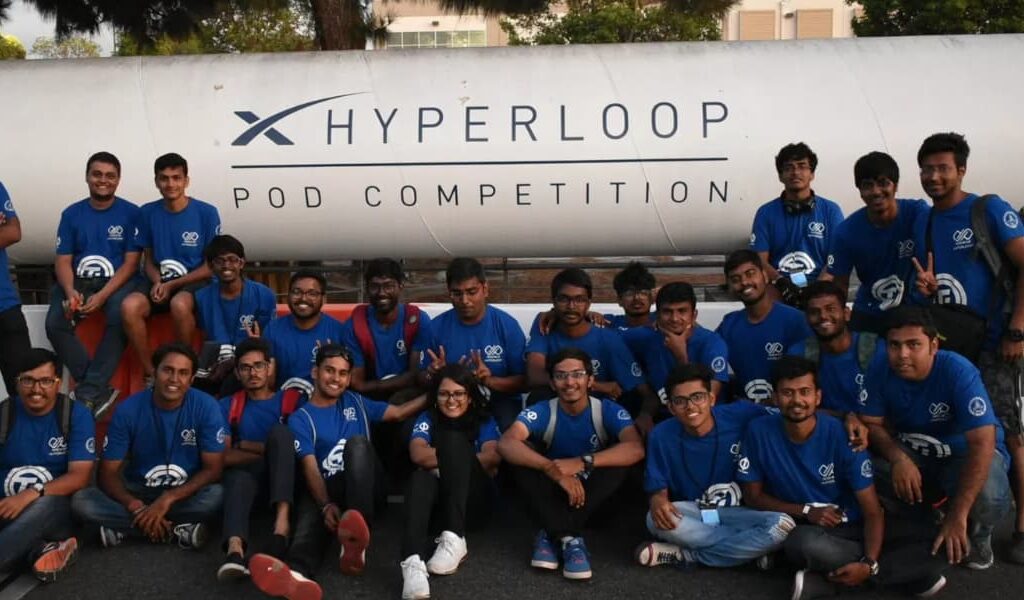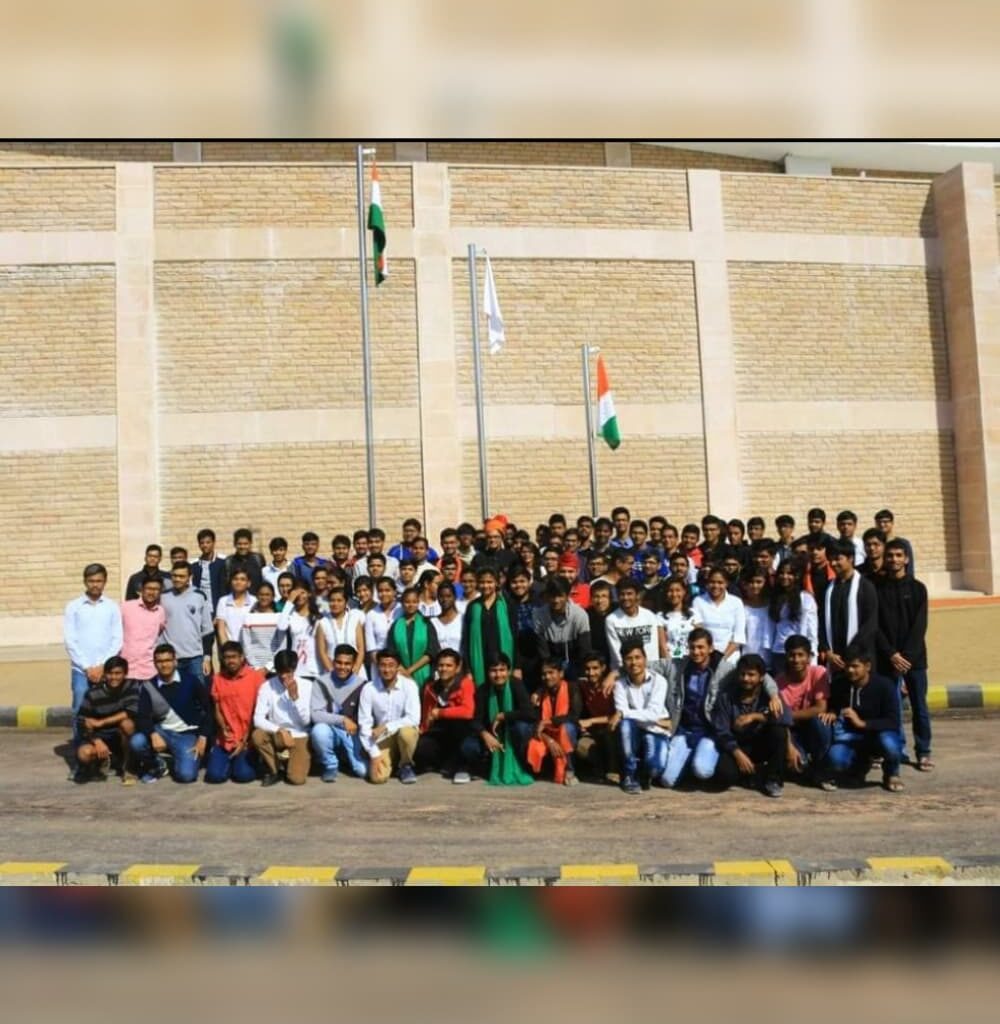Posted on 14th November 2022 | Content Warning – mentions of Sexual Harassment
Being one of only a few: Women in IITs, IISERs
By Saloni Mehta
What happens to the women who make it to these institutes against all odds? Lack of peer groups and mentorship, compounded by sexism, make for a long struggle.

IIT Madras team at the annual Hyperloop Pod Competition, sponsored by SpaceX. The gender gap is distinctly visible through this image (Sourced from the official website)
The abysmal gender ratio at the Indian Institutes of Technology (IITs) and the Indian Institutes of Science Education and Research (IISERs) is nothing new.

IISER Pune’s BS-MS programme has only 27% of female students as of March 31, 2022 (Sourced from the official website)
For example, IISER Pune has a total of 1,136 students enrolled in its BS-MS programme (as of March 31, 2022), of which only 314 are women; IISER Bhopal’s male to female ratio stands at 2:1. Of the approximately 120 students who joined the undergraduate course in electrical engineering at IIT Kanpur in 2017, only four were women.
The systemic deterrents to women’s admission into these public institutions of eminence are well documented — take these two pieces that brilliantly lay down the leaky pipeline. Unfortunately, the battle does not end with securing seats; it is just the beginning of their real struggles.
The lack of women in positions of power makes a major dent on the self-belief of female students, besides limiting their aspirations. Of the total 63 professors in the electrical engineering department at IIT Kanpur, only five are women.
IISER Pune’s biology department fares better in comparison, but still does not have a healthy representation: only five out of 35 regular faculty members are women. A professor at an IISER explains how the arduous challenges faced by women PhD candidates in the 1980s and 90s have translated into a present deficit of women in the role of professors and in positions of power at prestigious institutes of science.
Several faculty members were not willing to supervise women students, or provide them with active mentorship and guidance then. It was also rare for women to get adequate support from their families in the personal sphere, due to which they could not prioritise research. As a result, very few could continue in academia, and rise to senior positions,” she says.
According to Priyanka*, (BS-MS, IISER Pune, 2022), approaching professors for admission into their labs is a more daunting task for women and non-binary students than for men since most professors are also men. Male professors usually remain more informal with male students right from the beginning, which facilitates the initial conversation of working together. But the exclusion from this informal circle also makes it challenging for other students to reach out to professors.
“Having a Principal Investigator (PI) who mentors you is essential at the beginning. A positive experience is very likely to make sure you enjoy research and pursue it, even if you eventually move out of that particular PI’s lab. Unfortunately, male PIs sometimes have reservations talking to young women students, especially when compared with how open their communication with male students is,” she exclaims.

A typical classroom scene at IIT Madras. (Sourced from the official website)

IIT Kanpur has a disturbingly low ratio of female professors in the electrical engineering department: only 5 are women among a total of 63 professors. (Sourced from the official website)
Lack of peer groups
Science is too difficult to be done alone. The lack of a peer group can not only hamper the overall experience and holistic growth of a student, but also dilute the quality of their academic experience.
Women find it incredibly tough to make friends in IITs and IISERs as compared to their male counterparts. Sristi Jain (BTech CSE, IIT Jodhpur, 2021) explains: “Since there are only very few of us on campus, the likelihood of finding like-minded people among women remains low.” Avisha (BTech Electrical Engineering, IIT Kanpur, 2021) echoes Sristi, when she says “the camaraderie that the residents of a men’s hostel share is often missing in a women’s hostel.”
In several IIT and IISER campuses, there are no informal physical spaces for women and men to interact on a regular basis. For example, IIT Jodhpur and IISER Pune do not allow movement into another gender’s residence halls at all.
There are no space for a group of women to hang out with a group of men even just to watch a movie,” elaborates Priyanka*.
In IISER Bhopal, extensive hostel rules prevent inter-batch mingling. All these restrictions invariably mean women have less access to their seniors, who are mostly men.
Sexism persists
“A lot of predatory attention is directed towards you. It is like being watched all the time by people to label you either a ‘slut’ or a ‘bitch’,” Avisha mentions.
Aishwarya* (Engineering PhD candidate, IIT Madras) says sexual harassment by faculty is often not reported for the fear of a bad recommendation letter. She says women still have to answer (and sometimes lie too) questions regarding their marriage and maternity plans in doctoral programme interviews. “Women who return to complete their PhDs after a maternity break often fail to even get a word of encouragement from their guides.”
“Anything that we achieve is attributed to diversity quotas, in the most derogatory manner. Our male classmates do not think we are capable,” Sristi says. “My friend got an internship at the Max Planck Institute and it was automatically relegated to what is commonly called CQ (cunt quota, to be precise),” Avisha adds. This particular problem was exacerbated after the introduction of supernumerary seats in 2018, as most male students neither take an effort to understand the rationale behind the move nor comprehend that these are extra seats.
Priyanka* explains how women are more often burdened with lab housekeeping tasks, like washing beakers, for the entire team in IISER Pune’s Chemistry Department and how professors say things like “women can’t do math”. Aishwarya* also alleges that many male PIs allot receding attention to women students towards the end of the PhD thesis because they think “women are usually not as career-oriented as men”.

IIT-Jodhpur’s IEEE (Institute of Electrical and Electronics Engineers) conference (Credits: Sristi Jain)

TA-led class at IISER-Pune (Credits: Suryadeepto Nag)
Even professors not spared
Dr Preeti Aghalayam, Professor, Department of Chemical Engineering at IIT Madras, says “success in academic research is contingent upon collaboration, and there is certainly resistance to accepting women colleagues as equal collaborators by men.”
“Why are you teaching? Why don’t you go make a sandwich?” Priyanka* recounts how male students once shouted at a woman professor during a classroom session. “Women PIs are not taken seriously by male undergraduates. The after-term feedback for classes with women professors are rife with sexist comments,” she adds. IISER Pune’s Internal Committee (POSH)’s mandate includes addressing complaints from women faculty, in addition to students of all genders. However, they did not comment on whether any instance of sexism against women professors has been reported.
Avisha wonders how students like her would feel encouraged to pursue careers in STEM, when women professors are treated badly. “It affects your morale when you find only very few people like you in a career that you aspire towards,” she says.
There is progress, albeit slow. “We still have a long way to go, but my generation of women faced fewer obstacles than the ones before us. I expect this domino effect of better mentorship will translate to higher numbers of women rising to full professorships and leadership roles in a few years,” Dr Kaneenika Sinha, Associate Professor in Mathematics at IISER Pune, says.
Dr Aghalayam adds many in IITs now acknowledge the issue of gender imbalance in numbers and the more subtle aspect of inequity in experiences. Efforts are certainly afoot to address these issues within the system.
Possible solutions
- Supernumerary seats are working and this policy should continue. The gender ratio is much better now. Sristi’s juniors (the 2018 batch when supernumerary seats for women were piloted in IIT Jodhpur) have six times the number of women as compared to the batch that joined in 2016. Additionally, IIT Kanpur and IIT Madras are on the list of 30 pilot institutes for the Department of Science and Technology’s GATI (Gender Advancement for Transforming Institutions) initiative.
- Policies and infrastructure that facilitate healthy socialisation among different genders should be in place. For instance, IIT Kanpur allows free movement into hostels, irrespective of gender, except between 12 am and 6 am. Simran (BTech Aerospace Engineering, IIT Kanpur, 2022) affirms how this has helped her make friends and study buddies.
- Aggressive diversity hiring for faculty positions is needed. IIT Bombay instituted the “Shobha Dixit Chair Professorship” in 2021 to celebrate its women faculty’s contributions to STEM. This is the first chair endowment in an Indian university meant exclusively for women.
- Effective prevention of sexual harassment through sensitisation workshops and functional redressal mechanisms should work without curtailing the freedom of women or alienating them.
IISER Pune’s IC and IIT Kanpur’s Women’s Cell conduct mandatory gender-sensitisation/anti-sexism orientation programmes for new students every year. IISER Pune has had such sessions organised exclusively for staff and faculty. The success of these workshops, committees and women’s cells is yet to be determined. Perhaps, active monitoring mechanisms like student/faculty surveys will help. - Creation of feminist reading groups and women collectives by students is another good measure. IISER-Pune has a Women in Science Committee that aims at encouraging and celebrating women’s participation in the sciences.
Notes:
- *Name changed to protect identity
- All comments made by the subjects are only in their individual personal capacities
- All mentioned institutes were contacted for comments


Add a Comment